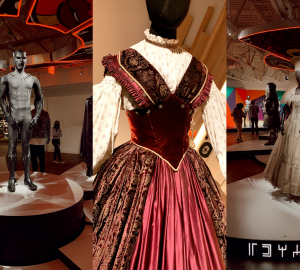By L.G. McCord
As SCAD Style wrapped up its first week in Atlanta, there have been well-rounded speakers to offer insight to the multitude of fashion industry-seeking students. On April 27, one a panel titled, Design With Retail in Mind, was conducted by Jaqui Lividini with responses from Brian Bolke and Robert Rufino.
Brian Bolke, co-owner of the stunning destination boutique Forty-Five Ten in Dallas, Texas, gave his point of view and offered his knowledge and experience behind the success of his business. Bolke explained that his buying process begins when a garment is introduced on the runway and that he watches the growth and popularity of that item until the garment hits his retail racks. Bolke also related the importance of visually merchandising his interior. He made the mistake in the early stages of his store by placing everything in its place too strategically; the boutique began to appear museum-like. The environment needed to be neat and organized, yet inviting enough for the customer to touch and try the product.
Over the course of the development of Forty-Five Ten, a clear vision of its customer began to emerge. Bolke learned more and more about “his customer and how people shop.” He suggested staying baby steps ahead, not leaps and bounds, to successfully influence the client’s fashion decisions. Do not intimidate the customer by being too fashion forward. Make the fashions easy for the customer to understand and easy to imitate.
A successful store is not composed of garments that the buyer of the store wants for himself or herself; the merchandise should be what the customer wants. As more time passed, the need for a balance of new fashion trends and what the customer wants became clear to Bolke. He confessed that even though leggings are not his favorite item to continuously purchase for his inventory, he must keep them in stock. Bolke also explained his triangle of buying theory: price, fit and style. Most people who try a garment fall into two of the three categories: for example, they can afford the price and admire the style, but the item does not fit. A sale is created when you fall into all three categories.
Bolke’s final advice was for the fashion designer. When developing a new line and striving to be purchased by a retail store, designers must make sure to market their products to a company that complements their style. Do not try to sell Vivienne Westwood-inspired street wear to a Tory Burch concept store.
Robert Rufino, senior editor for House Beautiful and former vice president of creative services for Tiffany & Co., offered his professional insight on visual merchandising and fashion editors. Rufino began his professional career at Henri Bendel in New York City, where he gained over 30 years of visual merchandising experience. Rufino explained the courageous risk that companies take when collaborating with innovative designers. Rufino specifically spoke of the Tiffany’s collaboration with Frank Gehry, how to stay in the commercial lines and create innovative design as well as how to appropriately merchandise pieces so the customers are comfortable touching and experiencing the product. The final comment on a successful collaboration is the advertising campaign.
Rufino, then, delved into the responsibility of the retailer, as the middle man, to educate the consumer on the purchased product. Speaking about his experience at Henri Bendel, Rufino explained how he and his colleagues displayed unknown designers in their window displays, achieving success in sales for the items shown. Rufino believes window dressing is the welcome mat for the customer.
When the topic of the current stage of social media and the new craze of fashion editors arose, the question became, “Who edits for the consumer?” With an over-saturated market of blogs, fashion television and magazines, where does the retailer fit? Robert commented, “Everyone is an editor — it’s nonsense. Find someone you trust: sales associates, specialty stores.” There was criticism of the current poll that listed the 99 most important blogs, including the popular blogger, 13 year old Tavi Gevinson. The conversation pointed in the direction of questioning bloggers, these self-titled fashion editors’ references, comparing their credibility with that of educated scholars who have spent years in classrooms becoming educated in fashion and those who have written master’s theses on the studies of fashion.
Bolke and Rufino gave insights into the changing world of fashion and retail. The anecdotes of their personal experiences in the fashion and merchandising industry gave SCAD students new perspectives with which to market themselves in the changing economy and the ever-developing flux of fashion.


























